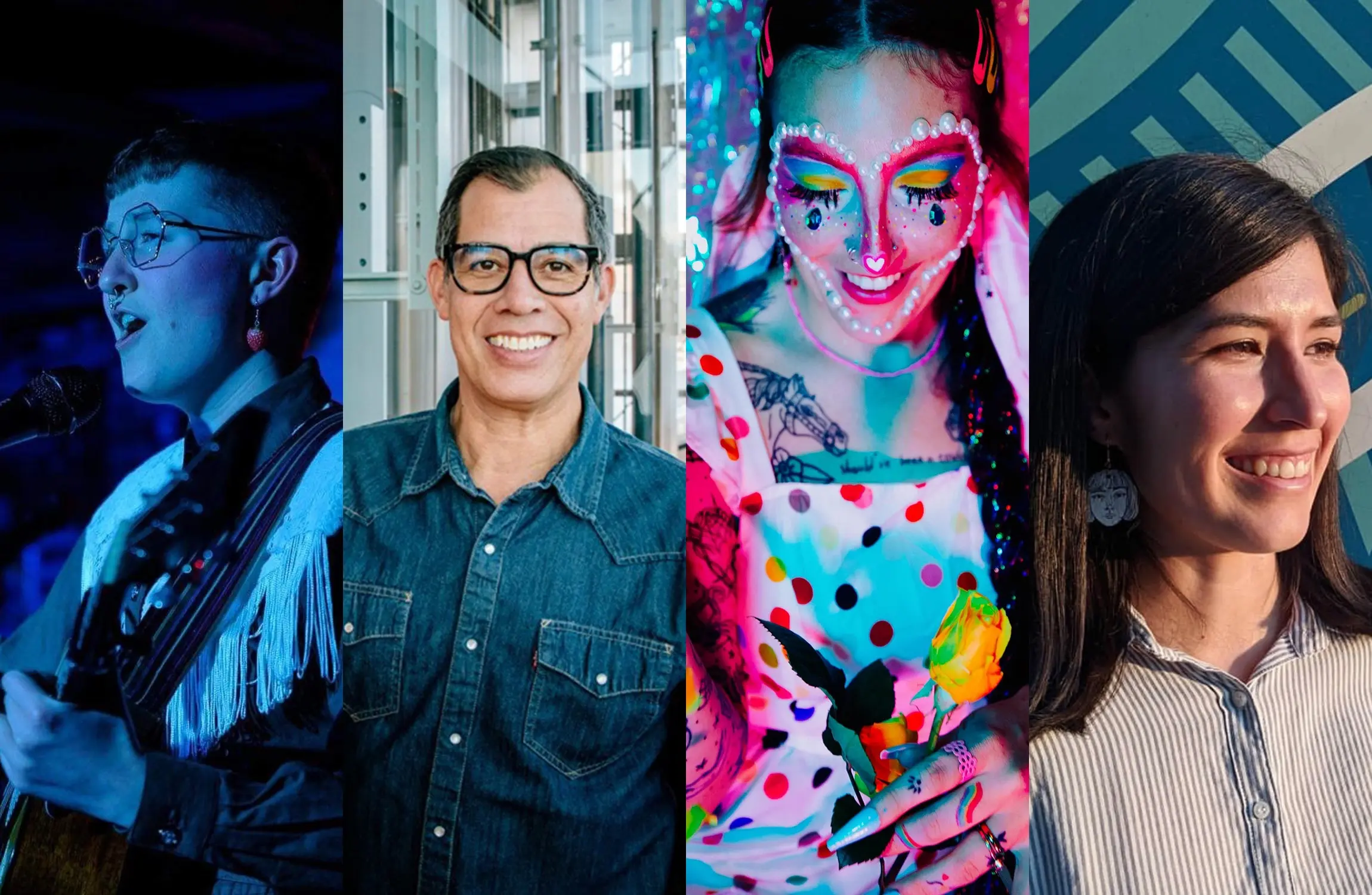
Reclaiming Heritage, Reimagining History: SLC Artists Manifest Their Own Destiny
Art
Rooted in a complex history steeped in colonization and religious settlements, Salt Lake City’s artistic pioneers are reclaiming their narratives and identities while fostering a sense of belonging in a landscape often overshadowed by the echoes of the past.
Many Utah artists have chosen to walk the line of being socially acceptable by choosing to acknowledge their heritage and embellish it with the identity they found for themselves, all represented in their art. To explore the delicate balance many in the SLC valley are trying to find, I sat down with a few artists who have found their footing: Emily Friend, Mary Nielsen, Jessica Wiarda and Jorge Rojas.
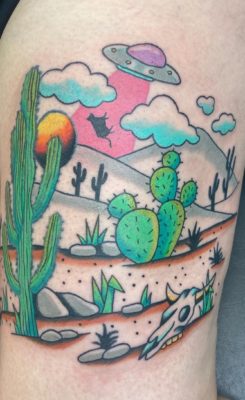
Emily Friend, a tattoo artist whose vibrant, rainbow-infused designs illuminate the SLC queer community, embodies the spirit of embracing joy through self-expression and a strong personal sense of identity. Her art, inspired by her Midwest upbringing, serves as a beacon of empowerment for those seeking to embrace their identities in a society that often demands conformity.
“I always had art [as] a way to escape and create this colorful world—full of horses and rainbows and clouds … People leave with a brightly-colored tattoo that brings them joy because what is on the outside can finally reflect what is on the inside.’’
Rainbow horses, barns, cows, churches with stained glass and of course, cowgirls, all harken to a Wild West revival that has emerged over the past few years in pop culture. Friend draws from memories in her past and breathes new life into them with a contemporary mindset. Because of this, Friend found herself tattooing many members of the SLC queer community. She managed to combine two juxtaposing themes for many who grew up struggling to love who they are and where they came from, allowing them to reclaim their own complex histories.
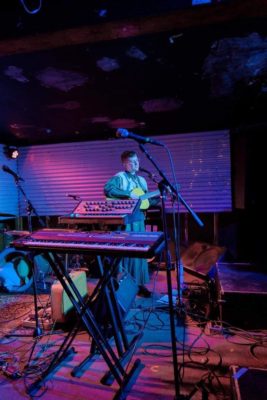
“I always had art [as] a way to escape and create this colorful world—full of horses and rainbows and clouds,” Friend reflects. “I held some very heavy things for people at times … I think there is a lot of catharsis in just giving your inner child a big hug and seeing them through the eyes of the adult version of you … People leave with a brightly-colored tattoo that brings them joy because what is on the outside can finally reflect what is on the inside.’’
For Mary Nielsen, known by their stage name Brother Nielsen, music serves as a vehicle for exploring the complexities of navigating being queer in Utah and their upbringing in the FLDS church. Through haunting folk melodies and introspective lyrics, Nielsen delves into the struggle of reconciling conflicting identities and the journey to self-acceptance.
“I can’t escape it. For me, it wasn’t just a religion, it was a culture,” Nielsen says. “I have a hard time separating myself from it. And then at one point, I decided I didn’t want to separate myself. I am who I am. I can’t run away from how I grew up and the things that influenced me.”
“The way that I create art and the way that I interact with other people and the way that I love them and the way that I connect to them is all because of this culture that I grew up in and I can’t unstitch it from my soul.”
Constantly questioning where they fit and striving not to disrupt everything they have ever known, underscores the depth of their journey. After leaving the church and permanently leaving home by the age of 20, they now face many contradictions of loving those who have loved them, encountering misunderstanding when it comes to expressing their true self. This internal conflict highlights the safety and solace found in being seen and understood, a hallmark of the queer community’s concept of found family—particularly profound in Utah, where many share this niche experience of trauma.
“The way that I create art and the way that I interact with other people and the way that I love them and the way that I connect to them is all because of this culture that I grew up in and I can’t unstitch it from my soul,” Nielsen says.
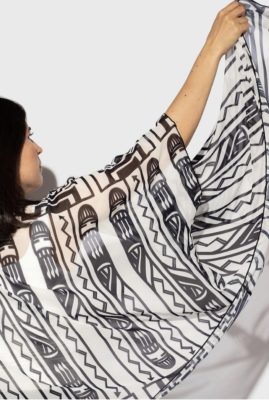
Jessica Wiarda, an indigenous artist and member of the Hopi-Tewa, is also no stranger to the weaving thread of heritage and its complexities—something that she, like Nielsen, has embraced and woven into her art. Wiarda uses her art to bridge indigenous tradition with modern expression, advocating for her community’s recognition and sovereignty.
“You can tell [from my art] that I was not raised on the res, but that I have the connection. I became more able to accept it because I was able to dip my toe into my Hopi family.”
“The more I’ve learned about my culture, the more I’m like, ‘Oh, there are a lot of things that are cool to show [to others],” Wiarda shares. “But there are things that maybe I don’t want to emphasize … it’s an ever-evolving art of cultural sensitivity to my own people.”
The community recently came together to fundraise for Indigenous Fashion Week, an initiative spearheaded by Wiarda, that highlights indigenous fashion designers in Utah. This recognition of indigenous nations and their artistry by the community is a massive accomplishment for Wiarda who, as a mixed-race woman, has taken her time to find balance between her two cultures, having one foot in her indigenous roots and another in the dominant white world of Utah.
Her confidence came from the art that she produced and shared with her family’s reservation. “I feel more confident showing the symbols [in my art]. My art is truly mine because I’m not traditional enough to do pottery,” she says. “You can tell who’s from the res[ervation]—their work is just way more detailed. It’s got a very different aesthetic. And you can tell that I was not raised on the res, but that I have the connection. I became more able to accept it because I was able to dip my toe into my Hopi family.”
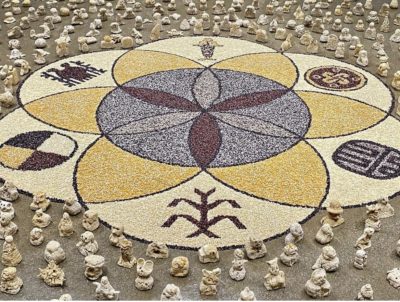
Like Wiarda, multidisciplinary Mexican artist Jorge Rojas learned how to balance his heritage in his artistic experiences with his advocacy for a more inclusive art scene in Salt Lake City. Originally born in Cuautla, Mexico, Rojas has spent his life traveling between Utah and Mexico.
“I often combine Mexican cultural themes that range from contemporary to pre-Hispanic topics, and question notions of nation, tradition and identity. My experience as a Mexican immigrant living in the U.S. allows me to position myself dialectically and strategically between cultures,” remarks Rojas.
“I feel a responsibility to bridge the past with the present … the ideas, concepts and traditions that I am bringing to the forefront in my work are the traditions of people who are very much alive.”
Over the past 30 years, Rojas has been an active participant in the Utah arts scene using his art to address issues such as immigration, inequality and abuse of power. He aims to cultivate community and amplify the voices of BIPOC artists who find themselves at a disadvantage in Utah. Both Rojas and Wiarda agree that the main challenges the BIPOC artist community faces are a lack of funding and a general lack of resources for their work.
“Being a Mexican immigrant has deeply influenced my art,” Rojas explains. “The colors and the textures, the music, the customs and ritual, the sense of history and injustice—[these] are all deeply part of me and show up in my work in various ways. I own and am proud of that. My work is a continuation of traditions.”
Rojas continues, “I feel a responsibility to bridge the past with the present … because the past and our connections to it have often been either erased or transformed into myth. The ideas, concepts and traditions that I am bringing to the forefront in my work are the traditions of people who are very much alive.”
These artists, each with their unique voice and perspective, are reshaping the narrative of Salt Lake City’s cultural identity. How you embrace your identity depends on your willingness to accept some truths and find peace with the fact that contradictory truths can exist within you. Balancing all these feelings within yourself is an ongoing art, never perfectly mastered. But remember, art is subjective. It doesn’t have to be flawless or finished to be beautiful and genuine.
Follow Emily Friend on Instagram at @cowgirlcoloringbook to see more of her tattoos; to book one yourself, send her an email at cowgirlcoloringbook@gmail.com. Check out Jessica Wiarda’s art at @jesswiarda or support her by shopping on her Etsy. You can find evidence of Jorge Rojas’ work just about anywhere in SLC, but you can also follow him at @keoqui and watch some of his performances on Vimeo. As for Mary Nielsen, you can follow them at @brothernielsen and catch them performing around the valley—most often at the open mic night held at Greenhouse Effect Coffee and Crepes every Sunday night.
Read more recent features about local artists:
Lunares Explores the Unseen Power of Tears in Lágrimas: Rain, Glitter
Kaycee Lane Turns Vintage Trash Into Kitschy Treasure